
|   |

|   |
27th OMC Guru Kelucharan Mohapatra Award Festival 2021 - Dr. Nita Vidyarthi e-mail: nitavidyarthi@gmail.com October 19, 2021 The prestigious Guru Kelucharan Mohapatra Award Festival is the annual flagship event by Srjan, Guru Kelucharan Mohapatra Nrtiyabasa, Bhubaneswar. It is a significant cultural happening of the country for keeping the arts alive and popularising them by presenting high quality concerts of music and dance, as well as theatre, while preserving the classical traditions of India through a five-day collective mix of representation of the performing arts by the choicest of high calibre artists of the country. Combating the present pandemic situation, the festival, for the second year running, was held virtually on the digital platform successfully from September 5th through 9th with the usual commitment and professional excellence under the guidance of Srjan's director, Guru Ratikant Mohapatra, an efficient administrator and a master organizer. The festival this year was dedicated to the fond memory of Guruma Lakshmipriya Mohapatra, who left for her heavenly abode on March 20, 2021. The great artist of tremendous acclaim was the fountainhead of inspiration for many Odissi dancers. 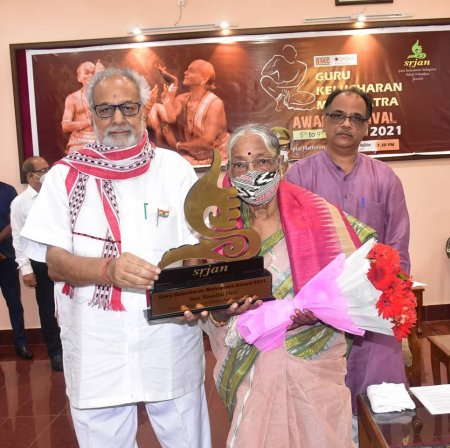 Prof. Ganeshi Lal, Binodini Devi, Ratikant Mohapatra Renowned Odia theatre actress Binodini Devi received this year's Guru Kelucharan Mohapatra Award. The coveted award carries a purse of Rs.1,00,000 and a citation. The Guru Kelucharan Mohapatra Yuva Prativa Samman 2021, which focuses on the commitment in reviving the all-important role of the solo artiste in the classical idiom went to Arushi Mudgal for Odissi dance and to Ramachandra Behera for Odissi music (mardala). The award carries a cash prize of Rs 25,000 and a citation. His Excellency, Hon'ble Governor of Odisha, Prof. Ganeshi Lal presented the awards at the Governor's House in the presence of dignitaries at the beginning of the final day of the festival with strict adherence to all the government mandated Covid-19 safety guidelines, while maintaining the required social distancing norms. The festival opened on the virtual medium with some memorable pictures of the legendary Odissi couple, Guru Kelucharan Mohapatra and his wife Guruma Lakshmipriya. Thereafter the welcome speech by Guru Ratikant Mohapatra, ushered in the program followed by those of veteran actress and dancer Dr. Vyjayantimala Bali and acclaimed actress and dancer Hema Malini, as well as other dignitaries. Every evening began with a dance recital followed by a musical presentation. DAY ONE  Sharmila Mukerjee Sharmila Mukerjee, a senior disciple of Guru Kelucharan Mohapatra and Founder-Director of Sanjali Centre for Odissi Dance, Bangalore, opened the evening with an Odissi recital. Seeking blessings from Lord Jagannath, she began with 'Saraswati Vandana', a Mangalacharan in raga Hamsadhwani, ektali after the ritualistic Pushpanjali and a Trikhandi pranam (triple salutation). The vandana "Swetapadmasana Devi Swetapushpashobhita" adorned with delicate steps of the dance form composed by the dancer herself, described the Goddess of knowledge, music and dance through a sophisticated execution. It was an image of divine beauty laced with spirituality of the Swetabasana Devi etched out by the dancer in the recorded baritone voice of the late Debashish Sarkar. And this became the starting point for the engaging virtual concert. 'Visarini,' her next piece in raag Darbari, was uniquely spread over the diction and exploration of the movements of Odissi through controlled postures while defining its grammar and technique and rested totally on pure dance. Sharmila, blessed with a tall and supple figure, sat centre-stage in an elegant still position with her back to the viewers. Dimmed, diffused lighting mystified, while the dancer began to move and then rotate her neck slowly (the griva recaka), then the upper torso, bending it from the waist -all in the sitting position with the refrain of the vocals in very slow motion displaying gradually the beautiful angaharas with unbelievable control. She gradually rose, bending backwards from the waist with dha, tadha, tadhikdhina… - with the rising impatience of the viewers - and then breaks into the exotic traditional tarijhum. Incorporation of jhula (swinging) and peacock movements was interesting. However, the piece cannot be categorized as a typical recital of Pallavi. An exciting experience followed as the dancing, composed with intricate patterns in the madhyalaya began with the ukuta (mnemonic syllables) of Satchidananda Das's mardala, Chandrachur Bhattacharya's sitar, Agnimitra Behera's violin and Srinibas Satpathy's flute, with the brightening up of the lights. A consummate dancer, Sharmila's abhinaya finesse had its moments as the khandita nayika in the concluding ashtapadi "Yahi Madhava." 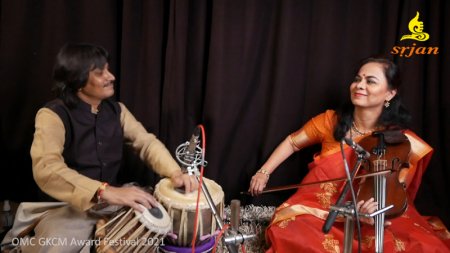 Ajeet Pathak and Sangeeta Shankar Violinist Dr. Sangeeta Shankar specializing in the Gayaki Ang or the "singing violin," began her recital in the Khayalang, in vilambit, ektal, unfurling the phrases of raag Abhogi and portraying her emotions and aesthetic self through traversing into madhyalaya and drut teentaal with a prolonged rendition. Through her sensibility, imagination and creativity to interpret and distil the essence of the respective genres of the classical arts - Khayal and Thumri - soaked richly with "meedhs and murkis" (glissando and briga), Sangeeta brought her violin close to the human voice. She arrived at a perfect conclusion of her repertoire with a Thumri of the Benaras gharana in ektal, replete with the subtlety and eloquence of love in raag Khamaj with her bowing of the instrument with elan. Pandit Ajeet Pathak accompanied her ably on the tabla. DAY TWO 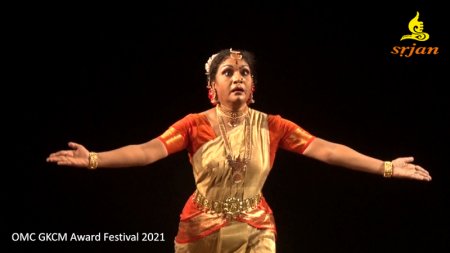 Anita Mallick Bharatanatyam artiste and founder of Saraswat Sanskriti Kendra, Kolkata, Anita Mallick, disciple of Guru Thankamani Kutty, commenced her recital with Ambika Pallavi, from the Lalitha Sahasranamam, in praise of the omnipotent Devi Ambika based on ragam Tilang and adi talam. She demonstrated her technical prowess in this number while moving from slow to an increasing tempo, with effective portrayal of the adavus and speedy teermanams. Her Bharatanatyam has a sculpturesque quality and so this nritta based number sprinkled with chiselled, geometrical stances was a delight to watch. This was followed by Krishna Anubhavam, in Ragamalika and adi talam, presenting the beauty, the majesty and captivating grace of the dark Godhead as he arrives in Mathura and the Gopis rejoice this drishyam (sight) through "Ya Drishtam" in the charming piece "Kanthihi Kaaliya" adorned with pure dance. She has the flair to carry off such luxurious poetry of astonishment, and the mood of the verses, but the required involvement in her abhinaya this evening fell short of expectations. The kirtanam "Shambhu Shiva Shambhu Swayambhu Gangadhara Sankara" in Revati ragam and adi talam, in obeisance to Lord Shiva, was well received. She concluded with the popular Tulsidas Ram bhajan "Thumaka chalata Ramachandra." Strong support came from O.S Arun and Vasudha Ravi on the vocals, on the mridangam by M.S. Sukhi and N.K Keshavan, Navinkumar and Palghat Sairam on the flute, on the violin by T. Sivaganesan and Srilakshmi Venkataramani, and on the nattuvangam by M.S. Sukhi and Sudharani Raghupathy. 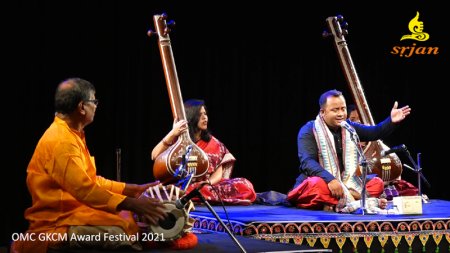 Rupak Kumar Paridha In growing admiration for Odissi vocalists of the young generation, Rupak Kumar Paridha gloriously sings traditional, classical Odissi music creating a musical biography. The rich timbre in his voice, musical knowledge, acquired skills and soulful singing provides a broad design to his presentation that remains in the memory of the listeners for a long time. And the evening's recital was no exception. He began with a short alaap in raga Kirwani and in ektali and gradually stepped on to a touching Gopal Krishna Pattanaik's "Kahachita taha nabolibo jaha dekhiligo maa…" in the raagangi format interspersed with "sa re ga re ga ma….".The elaboration of the phrases of the raga with brilliant high notes of magnificent flexibility, spiced with Satchidananda Das's mardala and Muralidhara Swain's impactful harmonium assigned a divine intent to his vocal music. It was the mighty flow of Jayadeva's ashtapadi, "Virachita chatu vachana" set to emotion filled music by Pt Raghunath Panigrahi in raag Bihag and ektali that submerged the listeners with an abundance of shringar rasa, fascinatingly projected by the longs and shorts of the melody by the star singer. Particular notes of the ragas were articulated with subtle grace in order to unfurl the inner feel of their structures in Sate ki bhangi kala, in raag Majh Khamaj and jati taal, Lajare sarigali aja in raag Mishra Khamaj and ektali, Barijakhi manaru mana in raag Mishra Pilu, khemta taal and Mohana murati chailo in raag Bhairavi and khemta taal. Delicate and melodious repetition of the line "Lajare re" in different ways, added volume to the inner search of the nature of the underlying sentiments of the lyrics and rasa. He concluded with a fine rendition of Sa Champu, "Shapatha ti mora re," composed in raag Simhendra Madhyamam and jati taal. Rupak Paridha's presentation was undoubtedly a very rewarding experience. The entire music recital was directed by Dr. Bijay Kumar Jena. DAY THREE 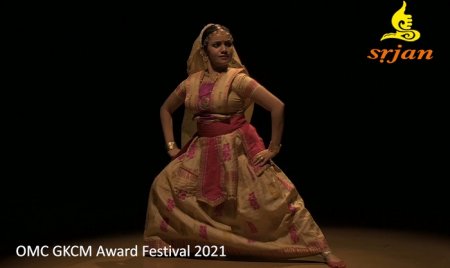 Anwesa Mahanta Dr. Anwesa Mahanta opened the evening with a Sattriya dance recital commencing with a "pravesh nach" on entry and salutation leading to the Vandana (offering) "Srimanta Sankararey Prakashila Govinder Naam" in the devotional vein. Sitting in a meditative pose, she immersed herself in the physiology of the music and its philosophical and poetic purpose with an intense expression of devotion and tender hasta mudras. Sattriya dance being an outcome of the all-pervading Bhakti movement of Assam during the 15th-16th centuries (Vaishnavite movement), is a ritual based dance. Remarking on this opening theme set to music by Hari Prasad Saikia, with a fine freedom of her expressive eyes, her execution caught the internalized mood of the line "Dhanya dhanya kalikaal….Dhanya dhanya Bharata barisho" of Nityananda Deka's singing with a captivating drawing power. Inspired by Saint Sankaradeva's play Rukmini Harana, the rich natya vocabulary of the tradition was portrayed in the abhinaya piece 'Rukmini Katha.' The distinctiveness of Anwesa's style of Sattriya movements and the dramatic dance-drama form with components adhered to Ankiya Bhaona in this number as a vasakasajjika nayika was replete with lasya elements. It was laced with stylised body inflexions portraying Rukmini yearning for Krishna as in the song "Hey Sakhi khujina payoji sakhi parampurush se naam muraru". With dance and rhythm composed by Bayanacharya Ghanakanta Bora the music was by Prabhat Sarma and Hari Prasad Saikia Barbayan. She was ably accompanied on the khol and cymbals by Hari Prasad Saikia Barbayan, on vocals by Nityananda Deka and Hari Prasad Saikia Barbayan, on the flute by Pradip Deka and on the violin by Devajit Goswami. Her concluding piece explored the Purush aspect of the classical tradition through the choreographic narrative of 'Markandaya Stuti.' The heavily pure dance based soulful piece represented the "Satyaa Raja Tama" gunas and displayed her strong body lines, skill and maturity. 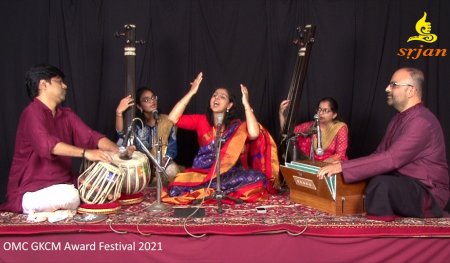 Manjusha Patil Manjusha Patil's Hindustani classical vocal recital commenced with raag Nand in teentaal with the vilambit Khayal "Dhundo baare saiyya". The robust, full-throated singing was heavy with fleeting taans traversing effortlessly through all the octaves emphasizing and sustaining certain figurations with high technical efficiency. The eloquent vocalising in mathematical permutations of musical syllables was rather a long display of graphic oscillations. However "Ajahu na aye" in drut teentaal with complicated graces displayed precision and aesthetic balance. "Kanha ranagawaa na daro" in raag Basant set to addha teentaal drew attention as did the concluding Marathi Abhang "Aga Vaikunthichya raya." Abhangs are rarely heard in concerts these days and this number written by Sant Kanhopatra and composed by Master Krishnarao reinforced the underlying spirituality in the rendition. Tanpura supporters Nupur Desai and Shirin Kelkar joined in this final item. Manjusha was accompanied by Suyog Kundalkar on the harmonium and Prasant Pandav on the tabla. DAY FOUR  Nikkita Banawalikar An extravagance of Kathak elements began with the opening of the evening with the stunning entry of a promising young talent, Nikkita Banawalikar, disciple of Guru Shama Bhate. She presented 'Avartan,' a complete cycle of rhythmic beats representing the entire traditional repertoire of a Kathak performance. A vibrant entry with the reverberating sound of "Om Gam Gam Ganapati" commenced Ganesh Stuti, followed by 'Taal Paksha' or the 'Nrittang' with compositions of rhythmic pieces performed to the accompaniment of tabla in the same bol patterns. Charmingly graceful Nikkita began in Teentaal madhyalaya and moved on to drut, with uthan, thaat, amad, padhant, tukras, playing with the number 5 in ginti while proving her rhythmic wizardry in her impeccable rendition. It was a real pleasure watching this elegant dancer, trained to perfection in the technique, negotiating the tihais effortlessly and arriving pat on the sam with ease. She concluded this segment majestically with a succession of 33 chakkars in full equilibrium with a final dha dha dha, forging her taiyari! The impassionate Bindadin Thumri "Kahe rokata dagar pyare Nandalal morey" saw her abhinaya skills in a luxuriant grace of involved expressions, juxtaposed with movements, soft, crisp and enchanting in the lyrical interpretation of the piece. Avartan concluded with a riveting tatkar in teentaal while exploring different fractions of the taals. Nikkita was ably accompanied on tabla by Tanay Rege, on the harmonium by Omkar Agnihotri and on the vocals by Aditya Apte whose Thumri rendition added an extra intensity to the dancing. 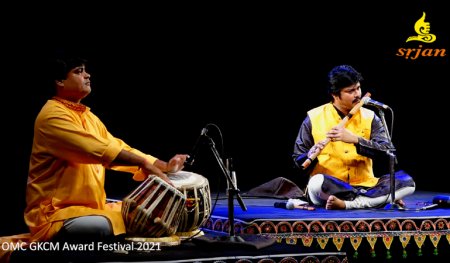 Abhiram Nanda Abhiram Nanda's approach to his flute execution adds emotion richly to any work of music yet its special beauty lies equally in its lack of pretentiousness. And his imposing recital in the second half of the evening proved it. Beginning with the sweet melodious raag Madhumanti in Vilambit (the Alaap), rupak taal (7 beats), he moved on to Jod and Jhala in teentaal, the last being the artist's stamping ground. When ornamentations fill out, the rhythmic pulse establishes in the jod. Recurring rhythmic pulses in Jhala reinforced the percussive resonance and taal and raag complemented each other with characteristic flourishes transforming the rendition into a poetry of sound. His concluding compelling 'Dhun' in raag Mishra Pahari in taal dadra and keharwa was a harmonious exploration of the uplifting tune of Mishra Pahari. Abhiram Nanda's work was noteworthy for its moving emotional content. The soulfulness of the recital was enhanced by the support of Biswaranjan Nanda on the tabla and Priyanka Rath on the tampura. DAY FIVE 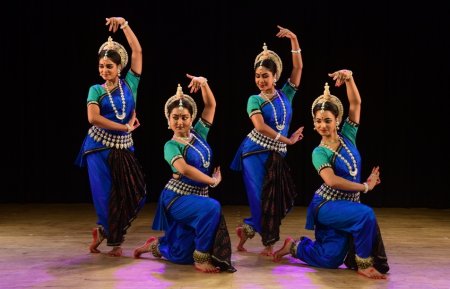 Srjan ensemble After the award ceremony at the Governor's house, the Srjan ensemble took to stage with an assortment of Guru Ratikant Mohapatra's neo-classical compositions of Odissi presentations that are innovative yet within the limits of the classical idiom. Their successful productions embracing a wide range of sahitya not only boast of brilliance of rendition without props, but impeccable and rigorous training of the dancers. Exquisite themes ranging from mythological story-telling pictures in productions like the intensely touching Antararama, Geetamritam, Kubja, to fine literary work Tyaga, relevant subjects of social concerns like Namami Gange, to Biswas, Bho Shambho and the brilliant Synthesis set to pulsating electronic music without indifference to classism, are only a few to account for the strikingly original productions. Guru Ratikant seeks a more complete knowledge of the idiom through his choreographic stenography, going into the sub-variations of the grammar of the art of dancing as also the music necessary to set it with his intelligence, in-depth knowledge and skill, all of which serve as a useful lens. Naturally, instruction under such a complete Guru results in a flow of magic. And execution, it goes without saying, is acquired only by long practice under expert and watchful eyes. The ensemble known for their perfection and disciplined understanding of execution, the nuances and mechanics of the steps began with "Vinayake Smaraney," an invocation to Lord Ganesha set to music by Vinod Kumar Panda. An assured performance of the new production 'Parameshwari Pallavi' in raag Parameshwari and taal khemta with Guru Ratikant's choreography set to Jateen Sahu's music, filled one with fresh admiration for both the choreographer and the dancers. The production 'Maati' by Odia poet Radha Mohan Gadanayak was a homage to mother earth with the usual involvement and execution of the full repertory, set to music by Lakshmikant Palit with script adapted by Jayadev Das. In the finale 'Shiva Shangsanam', an impressive experimental piece paying obeisance to Lord Shiva, Ratikant pushes the boundaries of dance innovation with its novel style of joyous execution. The dancers were Rajashri Praharaj, Ritu Sengupta, Pragna, Riyanka, Aiswariya Singhdev, Sipra Swain, Preetisha Mohapatra, Reebdhita Barua and Maya Krishnamurthy. The original kriti by Purandaradasa was adapted in Sanskrit by Pt. Nityananda Misra and the music adaptation of the original by Navaneeth Sundar was by Agnimitra Behera and Priyabrata Dash Mohapatra. A special mention for Debiprasad Mishra for the appropriate and artistic lighting. The MC of the festival Maya Krishnamurthy would do better to pay attention to the audible finishing of the sentences during her stage introductions. 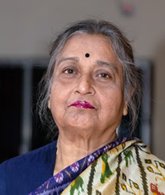 Dr. Nita Vidyarthi is a veteran critic of performing arts and writes on dance, music and theatre in leading publications. |